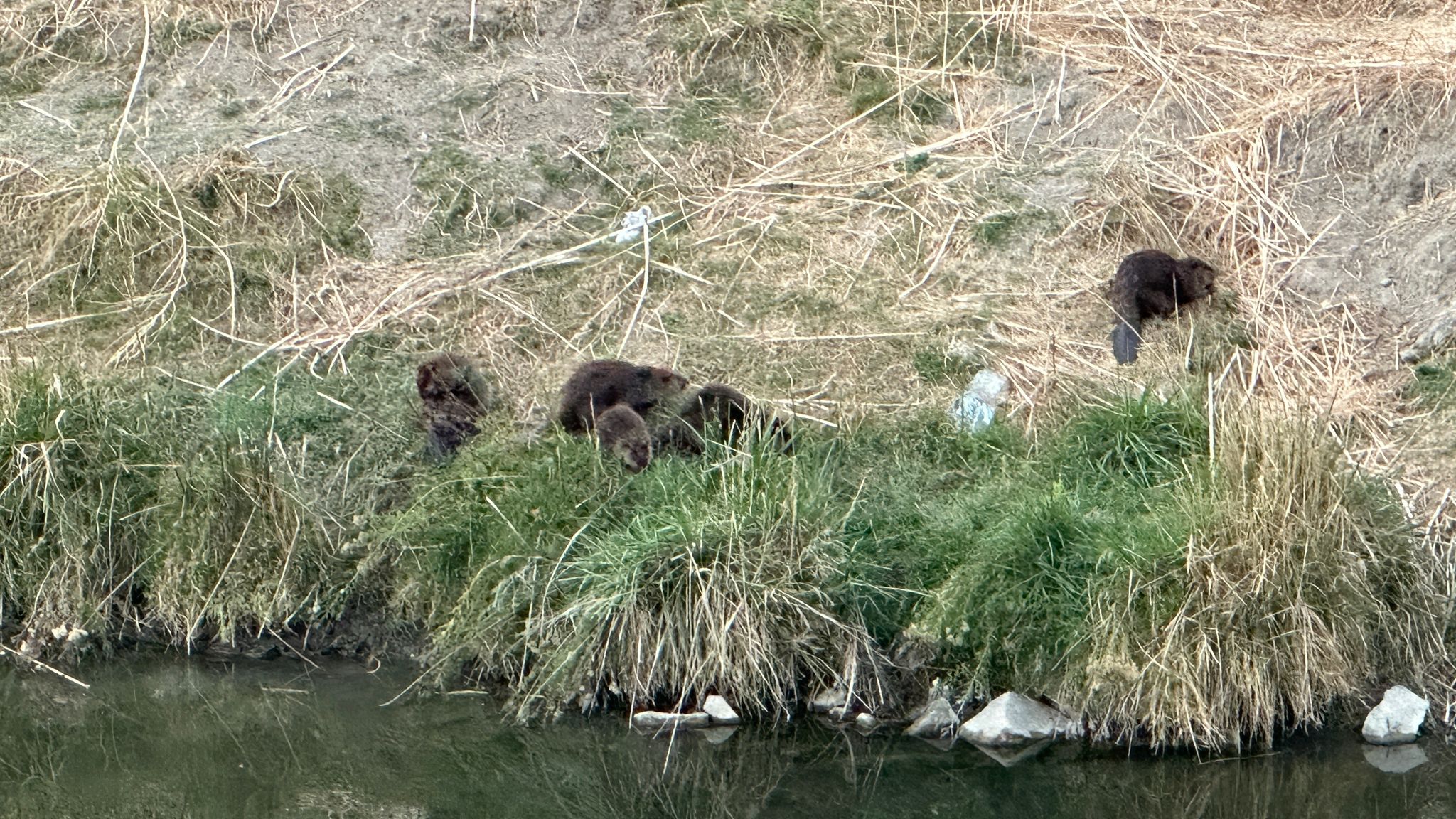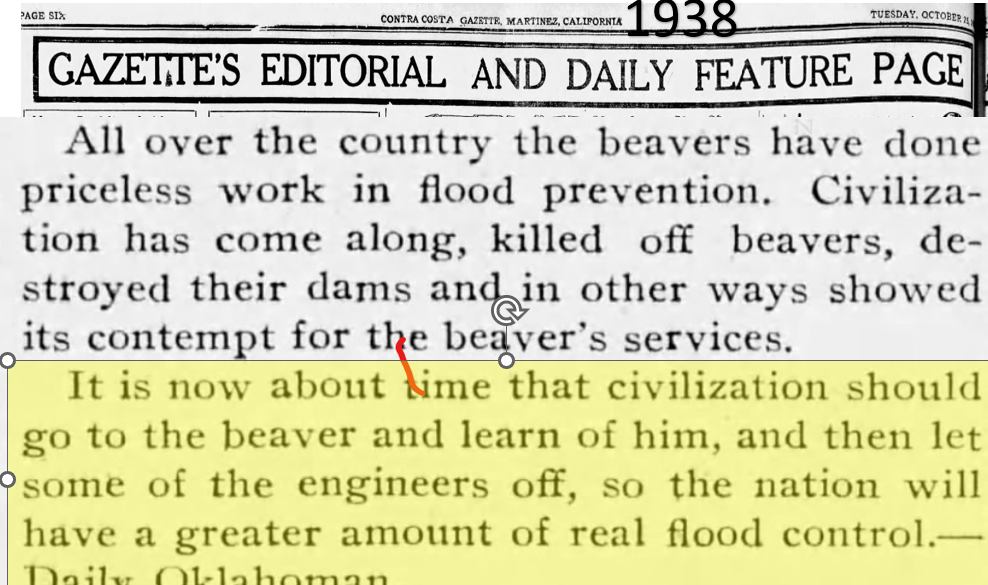I thought I’d remind you what a big deal the California Beaver Summit was.
C
Two fine days that changed the state forever. Your welcome.

Beavers all over the Bay Area. That’s what we’re looking for. As many beavers as there are people to save them. This weekend I heard about a new dam in the actual Walnut Creek between Monument Blvd and Bancroft in Concord.
I’ve known folks are seeing one or two beavers out that way over the last couple years, and we know a beaver was hit by a car near Mohr lane and taken to Lindsey wildlife a while back, but I wasn’t expecting this:
 Five? Five beavers on the bank? Looks to me like one adult and four 5-6 month old kits. I guess from this year’s birth. How is that possible?
Five? Five beavers on the bank? Looks to me like one adult and four 5-6 month old kits. I guess from this year’s birth. How is that possible?
What are they doing? They aren’t grooming, They appear to be browsing. But what on earth is there for them to be eating in all that dead grass?
Where do they live? How do they live? Should we assume these are kits with mom? Where is Dad? Is he just a beaver that got lucky or unlucky and went off looking for other pastures? Is he downstream?
These questions must be answered. We must know. There must be a tail cam installed. They are so dark. Almost black. Our beavers were brown. Does this mean they are not our decendents?
5 new beavers to worry about.
Ohhhhhh.
I came across this editorial recently. It is from a 1938 copy of the Martinez Gazette. A reprint of an earlier editorial in the Daily Oklahoman. After I popped my eyeballs back into their sockets I wanted to show it to you.
John Tamen 1938 beavers prevent flooding
Article from Oct 25, 1938 Martinez News-Gazette (Martinez, California)
Just to make sure you get the import here’s the money quote.
 Do not tell me Martinez didn’t know better. We all did.
Do not tell me Martinez didn’t know better. We all did.
On the plus side it suggest that when countries are impacted by fascism they are smarter about beavers. So that’s a plus.
It’s nice to see that beavers have gotten so popular even British Columbia is trying out the BRAT tool.
Beavers are industrious engineers in the animal kingdom and play a vital role in maintaining healthy ecosystems. Beaver dams create wetlands, which serve as crucial habitats for a diverse range of species and help to regulate water flow and mitigate the effects of floods and droughts. Understanding where to focus beaver-based restoration for habitat and climate change mitigation is critical, and that’s precisely what a recent project undertaken by Alessandro Freeman, BCIT student in the Masters of Ecological Restoration program, aimed to do.
Under the supervision of BCIT School of Construction and the Environment researcher Doug Ransome and in collaboration with Ducks Unlimited Canada, Alessandro Freeman set out to assess the effectiveness of a Graphical Information System (GIS) habitat model in identifying suitable locations for beaver-dam construction. The project, funded by the Mitacs Accelerate program and the Al Martin Habitat Conservation Trust Foundation (HCTF) fellowship, focused on using the Beaver Restoration Assessment Tool (BRAT) to pinpoint watercourses with high beaver habitat potential in the Cariboo Region of British Columbia.
Gee I wonder where beaver dams could be used to improve habitat for ducks. Could it be EVERYWHERE?
Using beavers to create and maintain wetlands, restore water flows, and restoring some of the most ecologically diverse habitats is an excellent example of nature-based processes. Mimicking how beavers build extensive wetlands saves money, restores critical ecological function to flood plains, creates important habitat for fish, amphibians, waterfowl, and for large species like moose. It is a perfect marriage between natural processes and ecological restoration.
BRAT summer
The BRAT, originally developed by Utah State University, evaluates various factors such as riverbank and wetland area vegetation, stream physical characteristics, and stream hydrology to estimate a stream’s dam capacity. Alessandro’s work involved testing the accuracy of this tool by comparing its outputs with field measurements taken at the streams in the Cariboo region. Additionally, he employed climate data with the BRAT’s hydrological outputs to model changes in stream flow, crucial for understanding the long-term viability of beaver habitats in the face of climate change.
It’s funny how once things get really really bad they are willing to try an unpopular solution. Like a huge company in dire trouble hiring a woman CEO.
Or bring on beavers to face climate change.
The results of Alessandro’s research sheds light on the BRAT’s capabilities and limitations for use in BC. “Overall, the BRAT was able to estimate the availability of preferred vegetation for beaver and accurately separated dam capacity based on vegetation,” says Alessandro. “It also identified streams with physical restrictions such as high gradient. However, the BRAT often overestimated water availability, with several streams being dry at time of assessment. Several streams with high dam capacity also scored poorly in overall habitat quality compared to other streams with low dam capacity.” These findings suggest that dam capacity alone is insufficient in finding sites with the highest chance of successful beaver occupation.
“Alessandro’s research is very timely,” says Doug Ransome. “Using and refining the BRAT tool, among others, are at the forefront of initiating field research trials in western Canada. Working with Ducks Unlimited and restoration practitioners and leaders, including Indigenous communities, BC Wildlife Federation, government, and NGOs, provides an excellent opportunity to study how well mimicking beavers will enhance our restoration goals in riparian and wetland environments.”
I’m starting to think that GIS is kind of like bluetooth. Even a lawn chair advertised having bluetooth will sell better to certain buyers. We don’t live building fake beaver dams in the creek or letting actual beavers do it, but tell us it can be paired with GIS and we’re all in!
I hope beavers follow in your footsteps. Alessandro.
Good Lord! Is that woman talking about beavers aGAIN? Doesn’t she ever shut up? Apparently the good folks at the Contra Costa Watershed Commion just can’t get enough. Or somebody better than I cancelled. Either way I’m off next week to spread the beaver gospel.
If you are similarly afflicted you can register here: